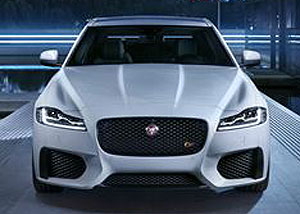2016 Jaguar XF
Jaguar has been on a roll lately, whether you’re talking about setting the pace in the F Pace or building our type of thrill ride with the F Type. Now they turn their efforts towards the more traditional XF midsize sedan. So, let’s see if they can continue to set their type of pace.
While the Jaguar F-type and F-Pace have certainly drawn lots of attention to the brand, its cars like this 2016 Jaguar XF that will truly have much more of an impact on the brand’s long term success.
Like most recent Jags and the trend of cars in general, this 2nd generation XF has dropped some pounds, riding on a new aluminum structure.
But it’s the powertrain options that are the biggest talking points about this new XF. That being the F-type’s supercharged 3.0-liter V6 available in two levels; base 340-horsepower and in upgraded S version with 380.
Both variations get an 8-speed automatic transmission with available all-wheel-drive. A diesel option will follow shortly.
 Our early drive time in Arizona was mostly spent in the more powerful XF S; and we found plenty of get up and go, no matter where we got up and went. Still, that muscle is delivered in a more civilized fashion than with brute force.
Our early drive time in Arizona was mostly spent in the more powerful XF S; and we found plenty of get up and go, no matter where we got up and went. Still, that muscle is delivered in a more civilized fashion than with brute force.
Like most vehicles, the XF has made the switch to electric power-assisted steering; and here we loved it. There’s plenty of feedback, along with a nice and direct feel. BMW take note!
We expected to see some improvement in handling, but we got even more than we anticipated. That lighter and stiffer chassis, along with the F-type inspired double-wishbone front and integral link rear suspension, provides a very agile feel, and should be just what was needed to make the XF much more competitive with its German rivals.
Ride quality equally falls on the firm side of things; not harsh, but surely stiffer than the typical American buyer will anticipate.
The ZF 8-speed is still good as it gets, delivering smooth and fast shifts no matter your driving style. Jag puts 0-60 right at 5.0-seconds. JaguarDrive Control offers a typical range of driving modes.
And, during our drive we did not find an extreme level of isolation, or disconnect. Still it was very quiet inside. The throttle is very aggressive, especially in sport mode. But unlike the boisterous F-Type, a fairly tame exhaust note reveals the XF’s clearly luxury character.
 That theme is really played out inside where the cabin is top drawer in both look and feel. Material quality has climbed exponentially; and there is plenty of space and comfort to be found at all seating positions.
That theme is really played out inside where the cabin is top drawer in both look and feel. Material quality has climbed exponentially; and there is plenty of space and comfort to be found at all seating positions.
Base gauges have a familiar look to them, but a configurable 12-inch TFT virtual gauge panel is also available. A new InControl Touch Pro system takes over the duties for infotainment, and worked well enough in our limited exposure.
The trunk area is well-finished, and holds a very generous 19.1 cubic-ft. of goods.
There are certainly more F-type notions to the updated exterior, but clearly the XF is its own cat.
The front end does wear a more aggressive look, with larger intakes and a more vertical grille, but in profile the same basic coupe-inspired shape of the previous car remains.
From the rear, things have been tidied up with cleaner lines and sharper fit to all of the pieces; which include LED taillights that are the most overt homage to the F-Type. Standard wheels are 18s, with the S rolling on 20s.
All of the expected safety systems including Autonomous Emergency Braking are available.
 So while this new XF has improved across the board and perhaps gotten a little more accessible, we think it’ll still appeal most to the buyer who’s looking for something other than a ubiquitous German sport sedan.
So while this new XF has improved across the board and perhaps gotten a little more accessible, we think it’ll still appeal most to the buyer who’s looking for something other than a ubiquitous German sport sedan.
The lighter weight and more efficient powertrain has improved the XF’s Government Fuel Economy Ratings to 20-City, 30-Highway, and 24-Combined. For an average Energy Impact Score of 13.7-barrels of oil consumed and 6.2- tons of CO2 emitted yearly.
Pricing starts at $52,895 for a 35t Premium, with the XF S beginning at $63,695.
The 2016 Jaguar XF was certainly due for an update, as the previous gen had been around since 2009. But, this thorough redesign does much more than just carry on business as usual in the midsize luxury sport sedan segment. With huge gains in both posh and performance, much like the F-type, it’s primed to have a major impact on its segment. This cat is on the prowl.
Specifications
- Engine: 3.0 liter V6
- Horsepower: 340 / 380
- Torque: 332 lb-ft.
- 0-60 mph: 5.0 seconds
- EPA: 20 mpg city/ 30 mpg highway
- Energy Impact: 13.7 barrels of oil/yr
- CO2 Emissions: 6.2 tons/yr
2024 Toyota Land Cruiser
Toyota’s Go Anywhere Globetrotter Returns To U.S.
Every once in a while, we all need a reset. A time to get back to basics and prioritize the things that really matter. Well, for the Toyota Land Cruiser that time is now. So, let’s find out if that means bigger and better things for Toyota’s iconic off-roader.
The Toyota Land Cruiser’s status among the global off-road community is legendary, and it’s hard to imagine there’s any corner of the earth where a Land Cruiser hasn’t kicked up a little dust or mud. Well, 2024 sees the return of the Land Cruiser to the U.S. market after a 3-year hiatus, getting a major reset for the journey.
The reset comes mostly by no longer being based on the large three-row “300-series” chassis, but a new version of the smaller “200-series,” now known as the J250. As with the latest Tacoma, it uses the Tundra pickup’s full-size steel frame.
While the main Land Cruiser model, which goes by simply Land Cruiser, is packed full of luxury and convenience features, there is also a stripped-down model known as the 1958, honoring the first year the Land Cruiser made landfall here in North America. And it is that 1958 we have here, and we were glad to see it, as it also celebrates the original’s back-to-basics approach as a blank canvas for you to personalize as you tackle more and more adventures.
Not that it’s fully stripped down, as 8-inch touchscreen infotainment, a 7-inch full-color multi-information display, and automatic climate control are still standard. Plus, some seriously durable materials, and great heated cloth front seats that throw off some get serious 1990s Tacoma vibes.
But outside, there’s a definite lack of flashy trim and basic looking 18-inch wheels with Yokohama Geolander all-season tires; plus, big chunky bumpers and tilt-up back glass, which is a rarity that we appreciate. Though there is a little too much plastic in places that are sure to see some abuse if you do any significant off-roading.
It even feels a little rough around the edges, but for us it just adds to the rugged old-school utility vibe in a good way.
We did just that, both here in the Mid-Atlantic as well as in the California desert; and while there are some tech-forward driving aids, the actual hardware is in most cases plenty to get things done. That includes standard full-time dual-range four-wheel-drive, locking center and rear diffs, and 8.7-inches of ground clearance. A front stabilizer bar disconnect is also available to allow for increased articulation.
Who needs a V6 or even a V8 when you’ve got Toyota’s i-FORCE MAX setup at your disposal with 326 horsepower and 465 lb-ft of torque coming from a 2.4-liter turbo-four with an electric motor sandwiched between the engine and its eight-speed automatic transmission. Low speed torque delivery is impressive. It even feels a little rough around the edges, which may be a turn off to some, but for us it just adds to the rugged old-school utility vibe in a good way.
And it certainly feels quicker than an off roader needs to be, with an instant torque dump as soon as we eased on the throttle at our Mason Dixon test track; helping us get to 60 in 8.1 seconds and through the quarter-mile in 16.3 seconds at 86 mph. Considering the Land Cruiser’s terrain conquering mission, it behaved quite well in our handling course; it was plenty responsive to inputs, with less body roll than we expected and plenty of grip from the tires. The steering was light and quick but as expected didn’t provide much feel. Other than significant nosedive, braking performance was exceptional. Only 107-feet to panic stop us from 60 mph.
With the shift to the smaller size, there’s no more third row available, and cargo capacity now comes in at 46.2 cubic-feet with a max of a still healthy 82.1. Now, the best part of the Land Cruiser’s return is the entry price of $57,445. That’s about 30-grand less than what the last Land Cruiser went for back in 2021.
Whether it’s over the top fashion trends, mullets, or zombies; just when you think they’re dead, they come roaring back to life. Of course, we’re much happier to see the resurrection of this 2024 Toyota Land Cruiser than any of those things. Toyota is one brand that still recognizes the value of full-framed rugged rigs and has also acknowledged that sometimes less really is more. The Godfather of Toyota off-roading is back and better than ever.







